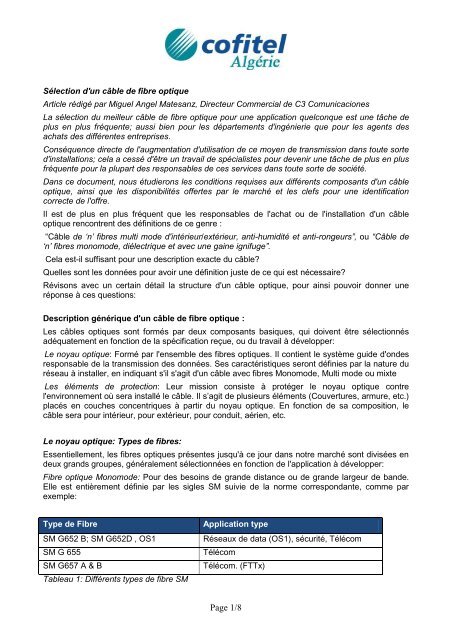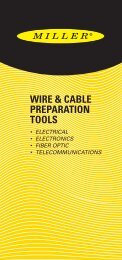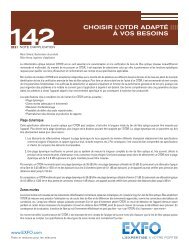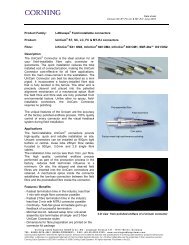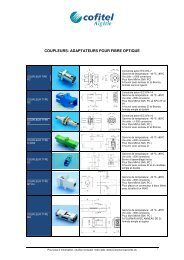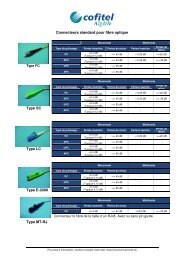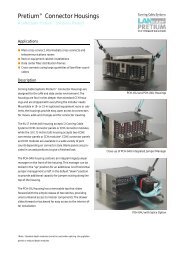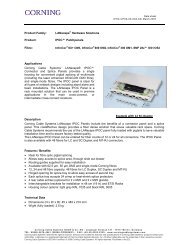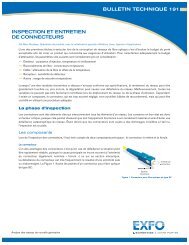Sélection d'un câble de fibre optique (fr) - info@c3comunicaciones.es
Sélection d'un câble de fibre optique (fr) - info@c3comunicaciones.es
Sélection d'un câble de fibre optique (fr) - info@c3comunicaciones.es
- No tags were found...
Create successful ePaper yourself
Turn your PDF publications into a flip-book with our unique Google optimized e-Paper software.
L<strong>es</strong> <strong>câble</strong>s fournis habituellement par l<strong>es</strong> différents fabricants sont généralement construis avec<strong>de</strong>s <strong>fibre</strong>s du type inclus dans la première ligne du Tableau 1, c'<strong>es</strong>t pour cela tout autre type <strong>de</strong>vraêtre indiqué expr<strong>es</strong>sémentFibre <strong>optique</strong> Multi mo<strong>de</strong>: Utilisée habituellement dans <strong>de</strong>s réseaux locaux (LAN), <strong>de</strong>télésurveillance ou <strong>de</strong> sécurité. Sa définition se compose <strong>de</strong> trois parti<strong>es</strong>: MM (Sigl<strong>es</strong>corr<strong>es</strong>pondants à la dénomination Multi mo<strong>de</strong>) Relation noyau/revêtement (Normalement 50/125ou 62,5/125) Type <strong>de</strong> <strong>fibre</strong>: OM1, OM2 ou OM3 d´après le tableau suivant:Distance 100BaseT 1000 Base Sx 1000 Base Lx 10G Base SR/SWOF300 OM1 OM2 OM1/OM2 OM3OF 500 OM1 OM2 OM1/OM2 SMOf 2000 OM1 SM SM SMTableau 2: Type <strong>de</strong> <strong>fibre</strong> en fonction <strong>de</strong> la longueur <strong>de</strong> la liaison EthernetL<strong>es</strong> réseaux hors LAN (contrôle industriel et vidéo ban<strong>de</strong> base) utilisent <strong>de</strong>s <strong>fibre</strong>s MM (typ<strong>es</strong> OM1ou OM2 indistinctement), <strong>de</strong> 62,5/125 ou 50/125 en fonction <strong>de</strong> la distance à atteindre.Le noyau <strong>optique</strong>: Typ<strong>es</strong> <strong>de</strong> constructionsPour pouvoir protéger convenablement l<strong>es</strong> <strong>fibre</strong>s <strong>optique</strong>s (contre l'humidité, résistance à latraction, etc.) et ainsi constituer la base <strong>d'un</strong> <strong>câble</strong>, on dispose <strong>de</strong> <strong>de</strong>ux systèm<strong>es</strong> :Construction serrée. Elle consiste à placer sur chaque <strong>fibre</strong> individuelle une protection plastiquepar extrusion directe, jusqu'à obtenir un diamètre <strong>de</strong> 900 µm.D<strong>es</strong> filatur<strong>es</strong> d'Arami<strong>de</strong> ou <strong>fibre</strong> <strong>de</strong> verre sont placé<strong>es</strong> au tour <strong>de</strong>s <strong>fibre</strong>s pour atteindre larésistance à la traction néc<strong>es</strong>saire, et le <strong>câble</strong> <strong>es</strong>t construit sur cette base.Son principal avantage <strong>es</strong>t une protection optimale anti-humidité ainsi qu'une flexibilité et unerésistance mécanique considérabl<strong>es</strong>.Son principal inconvénient <strong>es</strong>t la difficulté à utiliser, par <strong>de</strong>s raisons d´encombrement, <strong>de</strong>s <strong>câble</strong>s<strong>de</strong> plus <strong>de</strong> 24 <strong>fibre</strong>s.Figure 1: D<strong>es</strong>cription <strong>d'un</strong> <strong>câble</strong> <strong>de</strong> structure serrée1. Fibre <strong>optique</strong> (Noyeau + revétement: 250 ou 500 µm)2. Protection mécanique (900 µm)3. Arami<strong>de</strong> ou <strong>fibre</strong> <strong>de</strong> verre4. Gaine (LSZH, PE, etc.)Page 2/8
L<strong>es</strong> éléments <strong>de</strong> protection: L<strong>es</strong> gain<strong>es</strong>C'<strong>es</strong>t la partie du <strong>câble</strong>, qui, en contact avec l´environnement, le protègent contre l<strong>es</strong> éventuell<strong>es</strong>agr<strong>es</strong>sions d'agents extérieurs.Ell<strong>es</strong> sont généralement construit<strong>es</strong> avec <strong>de</strong>s différents matériaux plastiqu<strong>es</strong>, dont L<strong>es</strong>caractéristiqu<strong>es</strong> sont résumé<strong>es</strong> dans le tableau 4.Ainsi on peut l<strong>es</strong> classer comme gaine unique, ce qui <strong>es</strong>t souvent le cas <strong>de</strong>s <strong>câble</strong>s appelés“d'intérieur” et double gaine avec une protection interne (proche du noyau <strong>optique</strong>) et externe (encontact avec le milieu) séparé<strong>es</strong> parfois par une armure.Cette double gaine a comme mission la protection du noyau dans le cas <strong>de</strong> <strong>de</strong>struction <strong>de</strong> lapremière; comme il peut arriver en cas d'attaque <strong>de</strong> rongeurs ou poinçonnage acci<strong>de</strong>ntel.Matériaux/ProtectionMatériauGammetempératureRésist.Intempéri<strong>es</strong>Résistancehuil<strong>es</strong>Résistanceaci<strong>de</strong>sRésistancehydrocarbur<strong>es</strong>Résistance àl´eauRésistancemécaniqueRésistance aufeuApplicationtypePE LSZH PU PA NBRPolyéthylènelinéairePolyoléfineLSZHPolyuréthanePolyami<strong>de</strong>Caoutchoucnitrilique+80/-60 -25/+80 +75/-40 -40/+115 +75/-40Bonne Acceptable Acceptable Bonne ExcellenteMoyenne Médiocre Excellente Excellente BonneBonne Moyenne Mauvaise Médiocre BonneMauvaise Moyenne Excellente Bonne MoyenneExcellente Moyenne Acceptable Acceptable BonneBonne Acceptable Excellente Bonne BonneFumé<strong>es</strong>nociv<strong>es</strong>Nonpropagateur<strong>de</strong> la flammePose enextérieurFaibleémission <strong>de</strong>fumé<strong>es</strong>Nonpropagateur <strong>de</strong>la flamme etl´incendieIntérieur etcampusFumé<strong>es</strong>nociv<strong>es</strong>ExtérieurenterréFumé<strong>es</strong>nociv<strong>es</strong>DuctssaturésFumé<strong>es</strong>nociv<strong>es</strong>EnvironnementindustrielTableau 4: Résumé <strong>de</strong>s caractéristiqu<strong>es</strong> basiqu<strong>es</strong> <strong>de</strong>s matériels employés dans l<strong>es</strong> gain<strong>es</strong>Page 4/8
L<strong>es</strong> éléments <strong>de</strong> protection: l<strong>es</strong> armatur<strong>es</strong>.Leur mission, à l'intérieur du <strong>câble</strong>, consiste à lui of<strong>fr</strong>ir une protection supplémentaire contrecertain<strong>es</strong> agr<strong>es</strong>sions, qui peuvent être l'écrasement, l<strong>es</strong> attaqu<strong>es</strong> <strong>de</strong>s rongeurs, le feu, etc.Ils consistent généralement en éléments (baguett<strong>es</strong>, filatur<strong>es</strong>, tr<strong>es</strong>s<strong>es</strong> ou lam<strong>es</strong>) d'acier, ou <strong>fibre</strong><strong>de</strong> verre situé entre l<strong>es</strong> <strong>de</strong>ux gain<strong>es</strong> (si ell<strong>es</strong> existent) ou sous la gaine extérieure dans l<strong>es</strong> <strong>câble</strong>smono gaine.L<strong>es</strong> armur<strong>es</strong> métalliqu<strong>es</strong>, sont peut être plus efficac<strong>es</strong> comme protection contre l<strong>es</strong> rongeurs, maisell<strong>es</strong> présentent l'inconvénient <strong>de</strong> supprimer un <strong>de</strong>s avantag<strong>es</strong> recherchés dans une liaison <strong>de</strong><strong>fibre</strong> <strong>optique</strong> : sa caractéristique <strong>de</strong> liaison diélectrique.L<strong>es</strong> armur<strong>es</strong> diélectriqu<strong>es</strong> sont généralement <strong>de</strong> plusieurs typ<strong>es</strong>:Baguett<strong>es</strong> <strong>de</strong> <strong>fibre</strong> <strong>de</strong> verre: très soli<strong>de</strong>s, par contre ell<strong>es</strong> procurent une gran<strong>de</strong> rigidité au<strong>câble</strong>Filatur<strong>es</strong> <strong>de</strong> <strong>fibre</strong> <strong>de</strong> verre: tout en conservant la flexibilité, et produisent un effet dissuasifcontre l<strong>es</strong> rongeurs, mais son efficacité diminue dans l<strong>es</strong> courbatur<strong>es</strong>, par déplacement.Tr<strong>es</strong>se <strong>de</strong> <strong>fibre</strong> <strong>de</strong> verre: elle ajoute aux avantag<strong>es</strong> précé<strong>de</strong>nts (diélectricité et effetdissuasif) une protection permanente, et dans quelqu<strong>es</strong> <strong>câble</strong>s (comme le type CDADd'OPTRAL) elle constitue une barrière contre le feu.Tout en ayant compte <strong>de</strong>s considérations précé<strong>de</strong>nt<strong>es</strong>, il r<strong>es</strong>te un important point à analyser:Comment tout<strong>es</strong> c<strong>es</strong> caractéristiqu<strong>es</strong> sont-ell<strong>es</strong> porté<strong>es</strong> à la dénomination <strong>de</strong>s <strong>câble</strong>s <strong>de</strong> <strong>fibre</strong><strong>optique</strong>, pour une i<strong>de</strong>ntification facile et rapi<strong>de</strong>?L'i<strong>de</strong>ntification <strong>de</strong>s <strong>câble</strong>s <strong>de</strong> <strong>fibre</strong> <strong>optique</strong>:DESIGNATION DE CABLES CONFORME DIN-VDE 08881 2 3 4 5 6 7 8 9 10 11 121. J= Intérieur A= Extérieur2. V= Structure Semi serrée K= Str. Serrée W=Loose mono tube D= Loose multitube3. S= Élément central métallique4. Q= Noyau <strong>optique</strong> central avec bloqueurs d´eau sans gel F= Noyau <strong>optique</strong> avec gel5. (ZN)= Eléments <strong>de</strong> tirage non métalliqu<strong>es</strong> (ZN)B= Eléments <strong>de</strong> tirage non métalliqu<strong>es</strong>résistants aux rongeurs6. Y= Gaine PVC H= Gaine zéro halogèn<strong>es</strong> 2Y Gaine PE7. (SR)= Armature acier (Tôle ondulée)8. Y= Gaine PVC H= Gaine zéro halogèn<strong>es</strong> 2Y Gaine PE9. Numéro <strong>de</strong> <strong>fibre</strong>s. Tub<strong>es</strong> x <strong>fibre</strong>s10. Type <strong>de</strong> <strong>fibre</strong>. E= SM (Monomo<strong>de</strong>) G= MM (Multimo<strong>de</strong>)11. Noyau / Revêtement12. Paramètre <strong>de</strong>s <strong>fibre</strong>s. Atténuation et ban<strong>de</strong> passanteTableau 5 : Dénomination d´un <strong>câble</strong> <strong>optique</strong> d´après DIN-VDE 0888Page 5/8
Le tableau précè<strong>de</strong>nt décrit la composition du <strong>câble</strong> <strong>optique</strong> <strong>de</strong> l'extérieur à l'intérieur, permettantson i<strong>de</strong>ntification facilement. Ainsi le symbole J-KN(ZN)H12G50/125OM3 désigne un <strong>câble</strong> dutype:J: Câble d'intérieurK- Structure ajustéeZN: Éléments <strong>de</strong> traction non métalliqu<strong>es</strong>H: Couverture LSZH (zéro halogèn<strong>es</strong>)12: 12 <strong>fibre</strong>sG: Multi mo<strong>de</strong>50/125 OM3Une autre voie pour dénommer l<strong>es</strong> <strong>câble</strong>s <strong>de</strong> structure libre, utilisée par la majorité <strong>de</strong>s agentsprésents sur le marché, consiste à le décrire, <strong>de</strong> l, extérieur vers l´intérieur, en utilisant <strong>de</strong>ssymbol<strong>es</strong> du type <strong>de</strong>:P: PolyéthylèneT: Matériel thermoplastique LSZHD: FV : Fibre <strong>de</strong> verreS: AcierE: ÉtancheR: Plein1 : MonotubeAinsi, un <strong>câble</strong> type PESP-R 8 x SM désignerait un <strong>câble</strong> étanche avec une double gaine en PE,structure loose, avec une armature en acier, et 8 <strong>fibre</strong>s <strong>optique</strong>s SMFigure 3: Câble DPESP-1 d'OPTRAL1. Fibre <strong>optique</strong> 250 µm2. Macro tube plastique3. Élément résistent périphérique (filatur<strong>es</strong> <strong>de</strong> <strong>fibre</strong> <strong>de</strong> verre)4. Gaine intérieure PE5. Armature <strong>de</strong> plaque d'acier ondulé6. Gaine extérieure PEPage 6/8
L<strong>es</strong> <strong>câble</strong>s à structure serrée, utilisés généralement dans l<strong>es</strong> applications LAN et <strong>de</strong>télésurveillance et sécurité, utilisent généralement <strong>de</strong>s dénominations lié<strong>es</strong> à leur applicationgénérique.Ainsi, il <strong>es</strong>t <strong>fr</strong>équent que nous trouvions dans c<strong>es</strong> cas <strong>de</strong>s i<strong>de</strong>ntificatifs du genre <strong>de</strong> CDI (Câble <strong>de</strong>distribution d'intérieur) o CDAD (Câble <strong>de</strong> Distribution Armé Diélectrique).Il <strong>es</strong>t néc<strong>es</strong>saire alors <strong>de</strong> contraster leur construction avec l<strong>es</strong> conditions requis<strong>es</strong>, en ayantrecours à la fiche technique corr<strong>es</strong>pondante:Figure 4: Câble CDI d'OPTRAL (DIN J-K(ZN)H12G)1. Fibre <strong>optique</strong>2. Recouvrement ajusté3. Renforcement d'Arami<strong>de</strong>4. Couverture LSZHConclusion: Compte rendu <strong>de</strong> ce qui a été exposé antérieurement, il semble insuffisant <strong>de</strong> définirun <strong>câble</strong> <strong>optique</strong> par son application générique (par ex. “intérieur/extérieur” ou “anti-rongeurs-antihumidité”).Par contre, il <strong>es</strong>t plutôt néc<strong>es</strong>saire d'i<strong>de</strong>ntifier l<strong>es</strong> différents composants <strong>de</strong> sa structure (noyau<strong>optique</strong>, gaine ou gain<strong>es</strong>, armature) pour ainsi pouvoir être surs d'employer le matériel adéquat etobtenir l<strong>es</strong> résultats recherché<strong>es</strong>.Généralement, un manque <strong>d'un</strong>iformité dans l<strong>es</strong> éléments comparés peut <strong>de</strong>venir une confusion.Voyons un exemple:Câble avec “armure métallique et gaine pour extérieur, <strong>de</strong> 24 <strong>fibre</strong>s <strong>optique</strong>s MM 50/125”Peut corr<strong>es</strong>pondre à:Un <strong>câble</strong> type SP-124x50 OM1: mono gaine, armure d'acier, monotube, 24 <strong>fibre</strong>s <strong>de</strong>50/125 OM1 (apte pour Gigabit a 1300 nm jusqu´à 500 m.)Un <strong>câble</strong> <strong>de</strong> type PESP-R 24 x 50 OM3: Câble <strong>de</strong> double gaine, armure d'acier, multitube<strong>de</strong> 50/125 OM3 (apte pour 10Giga a 300 m.)Un <strong>câble</strong> type CDAM 24 x 50 OM2: Câble <strong>de</strong> structure serrée, double gaine, armure entr<strong>es</strong>se <strong>de</strong> <strong>fibre</strong> d'acier, 24 <strong>fibre</strong>s 50/125 OM2 (apte pour Gigabit a 850 nm et 1300 nmjusqu´à 500 m )Évi<strong>de</strong>mment, l<strong>es</strong> prix ne seront pas l<strong>es</strong> mêm<strong>es</strong>, mais l<strong>es</strong> pr<strong>es</strong>tations non plus, et le risque <strong>de</strong>commettre une erreur existe.Page 7/8
C'<strong>es</strong>t pour cela, il semble logique <strong>de</strong> déduire, que pour l'i<strong>de</strong>ntification correcte <strong>d'un</strong> <strong>câble</strong> <strong>optique</strong> il<strong>es</strong>t néc<strong>es</strong>saire d'exiger l<strong>es</strong> donné<strong>es</strong> suivant<strong>es</strong>:Noyau <strong>optique</strong>: Type et nombre <strong>de</strong> <strong>fibre</strong>s, type <strong>de</strong> structure (Loose ou serrée), typed'élément <strong>de</strong> traction (Élément central ou périphérique)Gain<strong>es</strong>: Nombre (Simple ou double) et type (Généralement PE ou LSZH. <strong>de</strong>s cas spéciauxPUR ou NBR)Armatur<strong>es</strong>: Diélectrique (Baguett<strong>es</strong>, filatur<strong>es</strong> ou tr<strong>es</strong>se) ou métallique (Tôle acier onduléeou tr<strong>es</strong>se)En général: Caractéristiqu<strong>es</strong> mécaniqu<strong>es</strong> requis<strong>es</strong> par le projet, ou type D'installation(Résistance à la traction, etc…)Une fois localisé<strong>es</strong> c<strong>es</strong> donné<strong>es</strong>, nous connaitrons et nous pourrons comparer l<strong>es</strong> différent<strong>es</strong>possibilités d´achat, et choisir avec une meilleure possibilité <strong>de</strong> succès.Page 8/8


